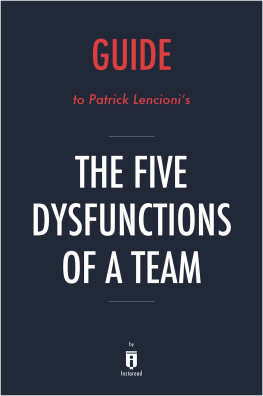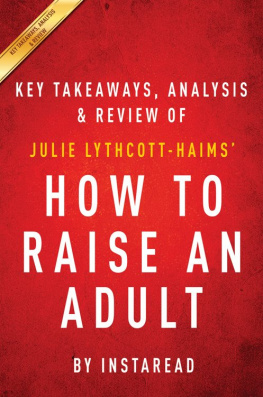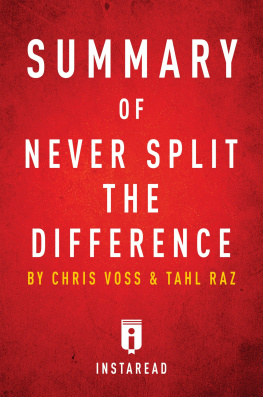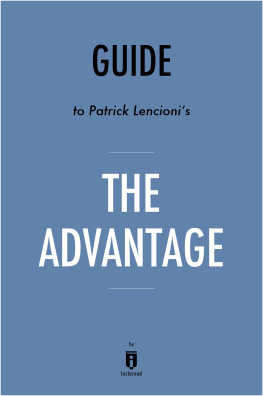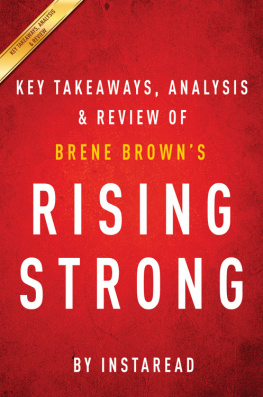Instaread Summaries - The Five Dysfunctions of a Team: A Leadership Fable by Patrick Lencioni | Key Takeaways, Analysis & Review
Here you can read online Instaread Summaries - The Five Dysfunctions of a Team: A Leadership Fable by Patrick Lencioni | Key Takeaways, Analysis & Review full text of the book (entire story) in english for free. Download pdf and epub, get meaning, cover and reviews about this ebook. year: 2015, publisher: IRB, genre: Business. Description of the work, (preface) as well as reviews are available. Best literature library LitArk.com created for fans of good reading and offers a wide selection of genres:
Romance novel
Science fiction
Adventure
Detective
Science
History
Home and family
Prose
Art
Politics
Computer
Non-fiction
Religion
Business
Children
Humor
Choose a favorite category and find really read worthwhile books. Enjoy immersion in the world of imagination, feel the emotions of the characters or learn something new for yourself, make an fascinating discovery.
- Book:The Five Dysfunctions of a Team: A Leadership Fable by Patrick Lencioni
- Author:
- Publisher:IRB
- Genre:
- Year:2015
- Rating:4 / 5
- Favourites:Add to favourites
- Your mark:
- 80
- 1
- 2
- 3
- 4
- 5
The Five Dysfunctions of a Team: A Leadership Fable by Patrick Lencioni: summary, description and annotation
We offer to read an annotation, description, summary or preface (depends on what the author of the book "The Five Dysfunctions of a Team: A Leadership Fable by Patrick Lencioni" wrote himself). If you haven't found the necessary information about the book — write in the comments, we will try to find it.
The Five Dysfunctions of a Team: A Leadership Fable by Patrick Lencioni — read online for free the complete book (whole text) full work
Below is the text of the book, divided by pages. System saving the place of the last page read, allows you to conveniently read the book "The Five Dysfunctions of a Team: A Leadership Fable by Patrick Lencioni" online for free, without having to search again every time where you left off. Put a bookmark, and you can go to the page where you finished reading at any time.
Font size:
Interval:
Bookmark:
Guide to
Patrick Lencionis
The Five Dysfunctions of a Team
A Leadership Fable
by
Instaread
Please Note
This is a companion to the original book.
Copyright 2015 by Instaread. All rights reserved worldwide. No part of this publication may be reproduced or transmitted in any form without the prior written consent of the publisher.
Limit of Liability/Disclaimer of Warranty: The publisher and author make no representations or warranties with respect to the accuracy or completeness of these contents and disclaim all warranties such as warranties of fitness for a particular purpose. The author or publisher is not liable for any damages whatsoever. The fact that an individual or organization is referred to in this document as a citation or source of information does not imply that the author or publisher endorses the information that the individual or organization provided. This concise companion is unofficial and is not authorized, approved, licensed, or endorsed by the original books author or publisher.
Table of Contents
Patrick Lencionis The Five Dysfunctions of a Team is about the reasons teams fail to work together for the collective good of an organization and ways to overcome these problems.
There are five dysfunctions that cause teams to fail. These include teams that do not trust each other, teams that do not engage in productive conflict, teams that cannot commit to collective decisions, teams that do not hold each other accountable, and teams that fail to focus on collective goals. The five dysfunctions are all interrelated. When a team falls victim to one of the five dysfunctions, they become vulnerable to the other four.
The initial step in addressing these dysfunctions is to build trust between team members. Once that is done, members will be ready to engage in productive conflict. Since the conflict means they have had a say in collective decisions, they will then be ready to commit to those decisions. Learning to commit to group decisions will make them more open to providing other team members with feedback about how the others are doing. Holding each other accountable, in turn, helps a team focus on collective goals. That is because no team member wants to let other members down, preventing them from reaching the goals.
Kathryn Petersen: The new CEO of an underachieving fictional company, DecisionTech, tries to build an executive team that works well together so the company can achieve the results it has failed to attain so far. She lays out the five dysfunctions of a team for her executives and asks them to work with her to build a cohesive team.
The DecisionTech executive team: This is the fictional team of executives that Kathryn Petersen tries to get to work together for the collective good of the company. She turns around most of them, but loses a couple along the way, one who was putting her career over the collective good.
- The first dysfunction of a team is an inability to trust.
- The second dysfunction of a team is fear of engaging in conflict.
- The third dysfunction of a team is lack of commitment to team decisions.
- The fourth dysfunction of a team is unwillingness to hold other team members accountable.
- The fifth dysfunction of a team is the inability to focus on collective goals as opposed to individual goals.
- A leader can use various techniques to help build trust among team members.
- To engage in productive conflict, team members must first understand what productive conflict is.
- The main ingredient for team member commitment is for every member of a team to have a say in the decision making process.
- It is often necessary to hold team members accountable for their shortcomings to force them to be better team players.
- Ways to overcome an inability to focus on collective goals include making the goals public and rewarding only those behaviors and actions that lead to achieving those goals.
The first dysfunction of a team is an inability to trust one another.
Analysis
The main obstacle to a team building trust is that many people are unwilling to be vulnerable with each other. That is, they are unwilling to show their strengths and their weaknesses. It is only natural that many people fear that any admission of weakness will be used against them some day. For example, a past mistake or vulnerability could be used to deny someone a promotion.
Some organizations deliberately foster a culture of distrust among their executive team members, believing incorrectly that it will deliver better results. A major newspaper chain used to do that by pitting key team members against each other. Typically, the CEO of one of the chains papers would hold one-on-one meetings with three members of the executive team at which he would announce that a promotion will be available soon and the three invitees are the forerunners for the job. The CEO may think that pitting these executives against each other will generate the best results for the company since each of the executives will be working hard to prove themselves. But the CEO is actually putting an emphasis on the results of the three executives individual departments, not the entire company. This kind of scenario usually sets in motion a bitter rivalry among the three executives, who will not work with each other in fear of giving their rivals the upper hand. And, although those executives departments may show great results, the companys results as a whole may be disappointing. Another downside of pitting executives against each other is that when one finally gets the promotion, those who were passed over often leave, costing the company top talent.
The second dysfunction of a team is fear of engaging in conflict.
Analysis
Productive conflict is the kind of conflict where ideas are debated openly so that all sides of an issue can be explored with the goal of making the best group decision possible when addressing the issue. Teams that are unable to trust each other will not engage in productive conflict. Instead of voicing their opinions, many people will hold back for fear of offending others or being seen as the odd person out.
One reason that many team members are reluctant to engage in conflict in a team setting that could generate the best decisions possible is that most organizations also tell their employees that conflict in the workplace is inappropriate. Not only do many organizations convey this message, but they also make the ability to get along with others one of the performance standards they use to evaluate employees for pay increases and promotions. After being told that engaging in conflict in the workplace will be counted against them, many employees find it difficult to accept the notion that they should now engage in conflict in a team setting. The leader of a team who wants productive conflict in the team setting needs to explain the difference between personality conflicts and conflict within a team setting. That may help prod reluctant team members toward engaging in the kind of productive conflict the leader wants.
The third dysfunction of a team is lack of commitment to team decisions.
Analysis
If team members hold back from offering their unfettered views on an issue during a team debate, they will usually not be committed to the final decision the team makes. Since they have not put their mind, heart, and soul into the discussion that precedes the decision or if they oppose the decision the group makes, they will likely not buy into it and try to make it work. If they have expressed their views clearly, and the team decides against them, they are more likely to buy into the team decision.
Next pageFont size:
Interval:
Bookmark:
Similar books «The Five Dysfunctions of a Team: A Leadership Fable by Patrick Lencioni»
Look at similar books to The Five Dysfunctions of a Team: A Leadership Fable by Patrick Lencioni. We have selected literature similar in name and meaning in the hope of providing readers with more options to find new, interesting, not yet read works.
Discussion, reviews of the book The Five Dysfunctions of a Team: A Leadership Fable by Patrick Lencioni and just readers' own opinions. Leave your comments, write what you think about the work, its meaning or the main characters. Specify what exactly you liked and what you didn't like, and why you think so.

